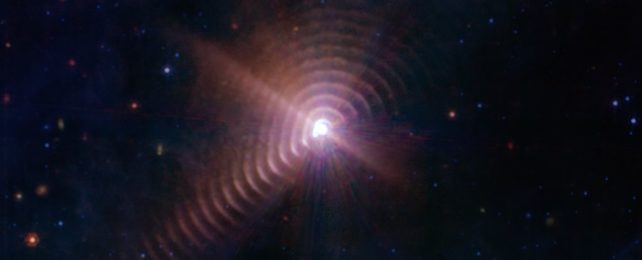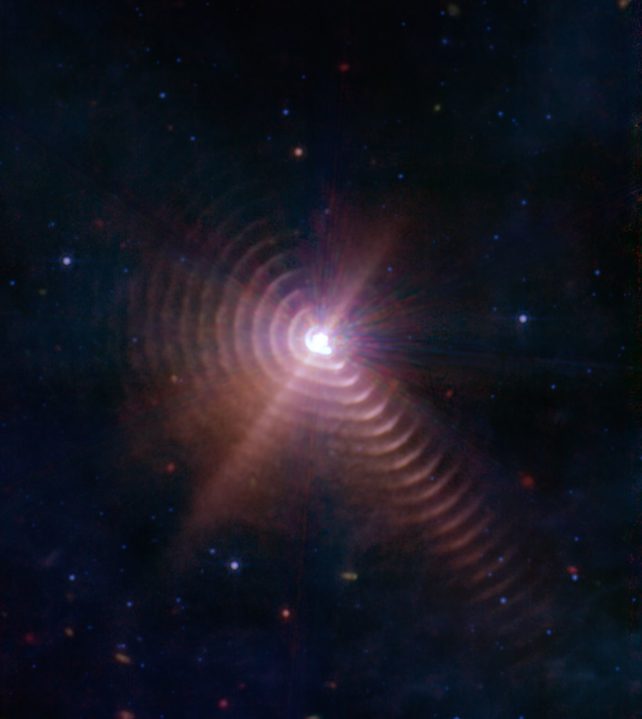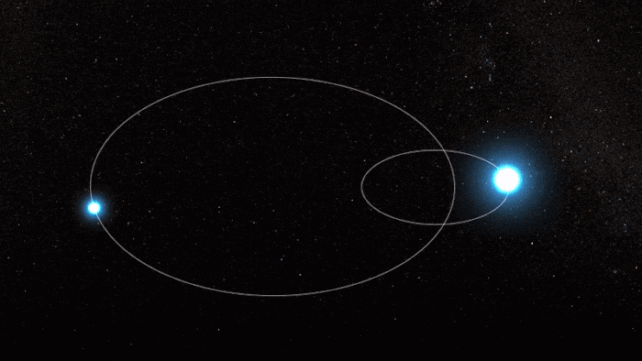 WR 140, as seen by JWST. The telescope's idiosyncratic diffraction spikes have been edited out to show the strange shape of the dust. (NASA/JPL-Caltech)
WR 140, as seen by JWST. The telescope's idiosyncratic diffraction spikes have been edited out to show the strange shape of the dust. (NASA/JPL-Caltech)Two rare stars whipping around one another in a wide, wild tango have given astronomers a unique opportunity to study the gentle slap of light against their dusty skirts.
The binary object called WR 140 is surrounded by a series of nested shells of dust that are slowly being pushed out into space, not just by the binary's stellar winds of charged particles, but the glow of radiation emitted by the stars themselves.
For the first time, scientists have been able to directly observe this radiation pressure in action, using infrared observations from the Keck Observatory to track a giant plume as it expanded out into space over a period of 16 years.
This helps explain what we're seeing in a recent image from the James Webb Space Telescope (JWST), the subject of a second paper, showing the blazing binary nestled amid a profusion of glowing dust shells.
"It's hard to see starlight causing acceleration because the force fades with distance, and other forces quickly take over," says astronomer Yinuo Han of Cambridge University.
"To witness acceleration at the level that it becomes measurable, the material needs to be reasonably close to the star or the source of the radiation pressure needs to be extra strong. WR 140 is a binary star whose ferocious radiation field supercharges these effects, placing them within reach of our high-precision data."

WR 140 is located around 5,600 light-years away in the constellation of Cygnus, and it's a rarity among rarities. It's what is known as a colliding wind binary, consisting of an extremely rare Wolf-Rayet star, and a blue O-type supergiant star companion – another rare object.
As we have previously explained, Wolf-Rayet stars are very hot, very luminous, and very old, blazing away at the end of their main-sequence lifespan. They are significantly depleted in hydrogen, rich in nitrogen or carbon, and losing mass at a very high rate. This lost mass is also high in carbon, which absorbs radiation from the stars and re-emits it as infrared light.
O-type stars, on the other hand, are among the most massive stars known, also very hot and bright; because they are so massive, their lifespans are incredibly brief, winking out after just a few million years.
Both stars in the WR 140 system have fast stellar winds, blowing out into space at around 3,000 kilometers (1,864 miles) per second. Both are therefore losing mass at a pretty furious rate. This is actually pretty normal. But the stars are orbiting each other in an elliptical, or oval, shape, which means they don't orbit evenly. They draw together for a close approach (periastron) and then apart again to a great distance (apastron).

At periastron, their powerful stellar winds collide, creating shocks and a giant puff of dust that expands outwards, creating a dust shell. The stars orbit each other once every 7.94 years, which means each new shell is created 7.94 years after the last one. This predictability means that objects like WR 140 are fascinating objects for studying dust production and acceleration.
But you may have noticed that the shape of the shells is peculiar, with one side stretched out, producing what has been described as a "squircle" shape. This is challenging to explain from just the stellar winds alone.
"In the absence of external forces, each dust spiral should expand at a constant speed," Han says.
"We were puzzled at first because we could not get our model to fit the observations, until we finally realized that we were seeing something new. The data did not fit because the expansion speed wasn't constant, but rather that it was accelerating. We'd caught that for the first time on camera."
But there's another explanation: radiation pressure. Electromagnetic radiation – light – exerts a tiny, tiny pressure on whatever it slams up against, due to the transfer of momentum from the photon to the surface. Photons are so small and massless that this is not going to affect your day-to-day life, but stars put out a lot of powerful radiation. Unfiltered, and in the vacuum of space, it can actually push matter. This is the principle behind lightsail technology.
When the team included radiation pressure in their models of WR 140, they were able to reproduce the peculiar shape of the shells ballooning around the binary.
"In one sense, we always knew this must be the reason for the outflow, but I never dreamed we'd be able to see the physics at work like this," says astrophysicist Peter Tuthill of the University of Sydney in Australia.
"When I look at the data now, I see WR140's plume unfurling like a giant sail made of dust. When it catches the photon wind streaming from the star, like a yacht catching a gust, it makes a sudden leap forward."
The Universe is, truly, full of wonders.
The team's research has been published in Nature, and the second paper on the JWST observations in Nature Astronomy.





No comments:
Post a Comment